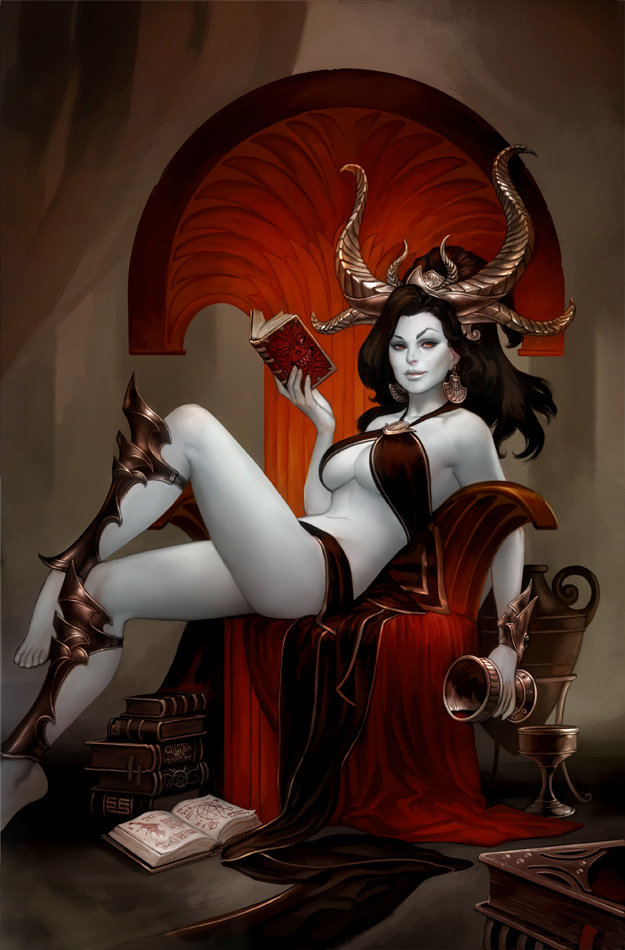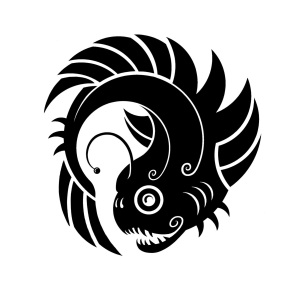To celebrate the 100th episode of #Art of Fantasy I thought we’d celebrate the origin of fantasy. And because “#Art of Fantasy” focusses on art, it makes sense then to approach it from that angle. So, today we look at ancient folklore and mythology through the eyes of contemporary artists.
Instead of the usual gods and monsters from Greek and Norse mythology, I also look at Slavic, African, and Chinese folklore and a few other little-known ones we don’t usually get to see.
So buckle up and enjoy!
Leshy by Dawid Jurek.
 The Leshy was a guardian spirit of the forests in Slavic folklore. Because of his propensity to lead travelers astray and abduct children, which he shared with Chort, or “The Black One,” the Leshy is believed by some to have been evil. Others viewed him as more of a temperamental being like a fairy.
The Leshy was a guardian spirit of the forests in Slavic folklore. Because of his propensity to lead travelers astray and abduct children, which he shared with Chort, or “The Black One,” the Leshy is believed by some to have been evil. Others viewed him as more of a temperamental being like a fairy.
Deep in the forest, the Leshi appeared more like a giant tree. However, as he wandered towards the edge of the forest he grew smaller and smaller. By the time he reached the forest’s edge, he’d be the size of a grasshopper.
Duwende by Brian Valeza

A Duende is a goblin-like creature from Iberian, South American, Chammorro and Filipino folklore. Duendes may also have some traits similar to goblins and kobolds, and is often considered the Spanish and Portuguese equivalent of a “sprite” or the Japanese yōkai. Mostly Duende is used as an umbrella term for any fairy-like being such as goblins, pixies and elves.
Psoglav by Aaron Nakahara.

The Psoglav was a mythical creature in Serbian mythology, believed to have existed in parts of Bosnia and Montenegro. It possessed the body of a human with the legs of a horse and a dog’s head. Its teeth were of iron and it had a single eye on its forehead.
Psoglavs lived in caves or in the dark lands which had plenty of gemstones and little to no sun. They ate human flesh and even dug out corpses to consume. There are many legends about them, particularly on the Istrian peninsula in Croatia.
Nokken by Kim Myatt

Nokken were shapeshifting water spirits in Germanic folklore who could also appear in the shape of other creatures. They were common to the stories of all Germanic peoples, although they are perhaps best known from Scandinavian folklore.
The related English “Knucker” was generally depicted as a wyrm or dragon, although more recent versions depict the spirits in other forms. Not all Nokken are considered wicked, but those who did harbor evil intent, possessed the sweetest songs, luring you with kisses and promises, closer and closer to the water’s edge where they could catch and drown you.
Surtr, Son of Muspelheim by Nikolas Lizotte

According to the Ragnarök prophecies in Snorri Sturluson‘s Gylfaginning, the sons of Muspell will break the Bifröst bridge, signaling the end of times:
“In the midst of this clash and din the heavens are rent in twain, and the sons of Muspell come riding through the opening. Surtr rides first, and before him and after him flames burning fire. He has a very good sword, which shines brighter than the sun. As they ride over Bifrost it breaks to pieces, as has before been stated. The sons of Muspel direct their course to the plain which is called Vigrid…. The sons of Muspel have there effulgent bands alone by themselves.”
Ereshkigal by Simon Eckert

In Mesopotamian mythology, Ereshkigal was the goddess of Irkalla, the land of the dead or underworld. Sometimes her name is given as Irkalla, similar to the way the name Hades was used in Greek mythology for both the underworld and its ruler, and sometimes it is given as Ninkigal, meaning “Great Lady of the Earth” or “Lady of the Great Earth”. Ereshkigal was the only one who could pass judgment and give laws in her kingdom. The main temple dedicated to her was located in Kutha.
Vali by Rasmus Berggreen

Vali (pronounced like the English word “valley”; from Old Norse Váli) is an obscure Norse god and the little we know about him, we’ve gleaned from a few scattered references in Old Norse literature. He’s the son of Odin and the giantess Rindr. When the god Baldr was killed, Vali avenged his death by killing Baldr’s slayer, another obscure divine figure named Hodr (No relation to Hodor).
The only other mention of Vali apart from his role in avenging Baldr’s death comes from a poem that lists him among the younger generation of gods who survive Ragnarok at the end of the Germanic mythological cycle.
Isis by Simon Eckert

Isis is a goddess from the polytheistic pantheon of Egypt. She was first worshiped in ancient Egyptian religion, and later her worship spread throughout the Roman Empire and the greater Greco-Roman world. Isis is still widely worshiped by many pagans today in a variety of religious ways, including the modern Goddess movement, and interfaith organizations such as the Fellowship of Isis.
Isis was worshiped as the ideal mother and wife as well as the patroness of nature and magic. She is often depicted as the mother of Horus, the falcon-headed deity associated with king and kingship. Isis is also known as a protector of the dead and goddess of children.
Raktabīja by Mukesh Singh

In Hindu mythology, Raktabīja was an asura or demon who fought with Shumbhaand Nishumbha against Goddess Durga and Goddess Kali or Goddess Chamunda. Raktabīja had a boon that whenever a drop of his blood fell on the ground, a clone of him would rise from that spot.
Shenlong by Natalia P. Gutiérrez

Shenlong is a spiritual dragon from Chinese mythology and the master of storms and bringer of rain. He is in equal standing to the celestial dragon, Tianlong. Spiritual dragons are azure-scaled and govern the wind, clouds, and rain. The Chinese people took great care not to offend Shenlong for fear of having it unleash bad weather, drought or thunderstorms.
Yelbeghen by Ömer Tunç

Yelbeghen is a multi-headed man-eating monster in the mythology of the Turkic peoples of Siberia, as well as Siberian Tatars. In some folklore, Yelbeghen is a winged dragon or serpent-like creature, while in others he is a giant ogre who rides a 99-horned ox. Some tales feature the Yelbeghen as having many heads and being the offspring of the Golden Witch, cohort to the lord of the underworld.
Perun by Mark Akopov

In Slavic mythology, Perun is the highest god of the pantheon and the god of thunder and lightning. There is some overlap with Odin and Thor. He is also associated with fire, mountains, wind, the oak, iris, eagle, firmament, horses and carts, weapons, and war.
According to Slavic myth, the world was represented by a sacred tree, usually an oak, whose branches and trunk represented the living world of heavens and mortals, whilst its roots represented the underworld, i.e. the realm of the dead. Perun was the ruler of the living world, sky, and earth, and was often portrayed as an eagle sitting on the top of the tallest branch of the sacred tree, from which he kept watch over the entire world.
Anansi by Luke Maddox

Anansi or Ananse is an African god, probably better known from Neil Gaiman’s Anansi Boys. Anansi often takes the shape of a spider and is seen as the spirit of all knowledge of stories. He is also one of the most important characters of West African and Caribbean folklore. He is also known as Kwaku Ananse, and Anancy; and in the southern United States he has evolved into Aunt Nancy. He is a spider, but often acts and appears as a man. The Anansi tales originated from the Ashanti people of present-day Ghana.
West Africans originally considered Anansi the creator of the world and sometimes intermediary between humans in their dealings with the sky god Nyame. He supposedly persuaded Nyame to give both rain and the night to people. Anansi is mostly seen as a crafty and cunning trickster who makes life more enjoyable for himself and more difficult for others by fooling humans, animals, and even the gods themselves.
And last, but not least, Cthulhu by Guillem H. Pongiluppi

Technically not folklore, but then again, how do you know? Cthulhu is a “fictional” cosmic entity created by H. P. Lovecraft. It was first introduced in the short story “The Call of Cthulhu,” published in the pulp magazine Weird Tales in 1928. Considered a Great Old One within the pantheon of Lovecraftian cosmic entities, the creature has since been featured in many popular culture references. Lovecraft depicts Cthulhu as a gigantic tentacled beast worshiped by cultists. The Lovecraft-inspired universe where Cthulhu and its fellow entities exist is called the Cthulhu Mythos.
I want to give thanks to everyone who has followed this blog and this series. It’s been a hell of a ride and I’m proud that we’ve reached 100 posts. I see no reason to give it up just yet. I also want to give a special shout-out to my friend and fellow writer, R.A. Williamson. He helped me brainstorm this week’s blog post. I reviewed his awesome story Little Mouse here. To find out more about him and his work, click here.
Cheers!
Woelf

Sources:

Ha-ha, that Leshy :D.
LikeLike
I’m busy writing a fantasy called, “The Dead God” inspired by Slavic lore. There are some pretty awesome tales to be found there.
LikeLike
These are pretty damn awesome. The Duwende is quirky and awesome, and that Shenlong is awe inspiring.
LikeLike
Thanks! Glad you enjoyed it. You should click through to the galleries of the artists for more of their awesome work.
LikeLike
WOW! Truly an outstanding post. Loved the illustrations and the stories. Especially that last illustrtion of Cthulhu is fantastic!!!
LikeLike
Thanks! This was an awesome post.
LikeLiked by 1 person